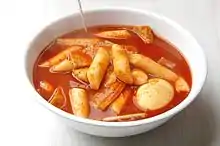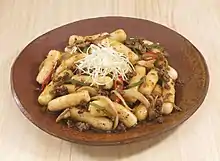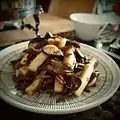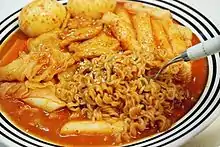Tteokbokki
Tteokbokki (떡볶이); or stir-fried rice cakes is a popular Korean food made from small-sized garae-tteok (long, white, cylinder-shaped rice cakes) called tteokmyeon (떡면; "rice cake noodles") or commonly tteokbokki-tteok (떡볶이 떡; "tteokbokki rice cakes").[1][2] Eomuk (fish cakes), boiled eggs, and scallions are some common ingredients paired with tteokbokki in dishes. It can be seasoned with either spicy gochujang (chili paste) or non-spicy ganjang (soy sauce)-based sauce; the former being the most common form,[3] while the latter is less common and sometimes called gungjung-tteokbokki (royal court tteokbokki).
 | |
| Alternative names | Stir-fried rice cakes |
|---|---|
| Type | Bokkeum |
| Place of origin | Korea |
| Associated national cuisine | Korean cuisine |
| Main ingredients | Tteok (rice cakes), fishcake, gochujang |
| Variations | Gungjung-tteokbokki, rabokki |
| Korean name | |
| Hangul | 떡볶이 |
|---|---|
| Revised Romanization | tteokbokki |
| McCune–Reischauer | ttŏkpokki |
| IPA | [t͈ʌk̚.p͈o.k͈i] |
Today, variations also include curry-tteokbokki, cream sauce-tteokbokki, jajang-tteokbokki, seafood-tteokbokki, galbi-tteokbokki and so on. Tteokbokki is commonly purchased and eaten at bunsikjip (snack bars) as well as pojangmacha (street stalls). There are also dedicated restaurants for tteokbokki, where it is referred to as jeukseok tteokbokki (impromptu tteokbokki). It is also a popular home dish, as the rice cakes (garae-tteok) can be purchased in pre-packaged, semi-dehydrated form.
History
The first record on tteok-bokki appears in Siuijeonseo, a 19th century cookbook, where the dish was listed using the archaic spelling steokbokgi (복기).[4] According to the book, tteok-bokki was known by various names including tteokjjim (steamed rice cakes), tteok-japchae (stir-fried rice cakes), and tteok-jeongol (rice cakes hot pot). The royal court version was made from white tteok (rice cakes), sirloin, sesame oil, soy sauce, scallions, rock tripe, pine nuts, and toasted and ground sesame seeds, while the savory, soy sauce-based tteok-bokki was made in the head house of the Papyeong Yun clan, where high-quality soy sauce was brewed.[5] In this version, ingredients such as short ribs were common. The name tteok-bokki also appears in the revised and enlarged edition of Joseon Yori Jebeop, where it is described as a soy sauce-based savory dish.[5]
It is believed that the spicy variant of tteok-bokki made with gochujang-based sauce first appeared in the 1950s. When Ma Bok Lim participated in the opening of a Chinese restaurant, she dropped tteok into hot sauce accidentally and ate it, and found that it was delicious. After that, she began selling it in Sindang and it has since become the most common variant of tteok-bokki.[6] Today, the typical tteok-bokki purchased and eaten at bunsikjip (snack bars) and pojangmacha (street stalls) are red and spicy, while the soy sauce-based, non-spicy version is referred to as gungjung-tteok-bokki (궁중떡볶이; "royal court tteok-bokki"). Rice tteok rose in popularity as the South Korean economy developed, and various versions of the dish have proliferated since. As it was once a working-class dish, wheat tteok was often substituted for rice tteok.[5]
Varieties
Like other popular Korean dishes, tteok-bokki has seen numerous variations and fusions. Boiled eggs and pan-fried mandu (dumplings) were traditionally added to tteok-bokki. Ingredients such as seafood, short ribs, instant noodles, chewy noodles are also common additions to the dish.
Variations based on added ingredients
Haemul-tteok-bokki, (해물떡볶이; "seafood tteok-bokki") features seafood as its secondary ingredient.
Galbi-tteok-bokki (갈비떡볶이; "short rib tteok-bokki") features short ribs as its secondary ingredient.
Ra-bokki (라볶이; "instant noodle tteok-bokki") and jol-bokki (쫄볶이; "chewy noodle tteok-bokki") are similar variants which add noodles to tteok-bokki. Ra-bokki adds ramyeon (ramen) noodles, and jjol-bokki adds chewy jjolmyeon wheat noodles.
Jeukseok-tteok-bokki
Jeongol (hot pot)-type tteok-bokki is called jeukseok-tteok-bokki (즉석떡볶이; "on-the-spot tteok-bokki"), and is boiled on a table-top stove during the meal.[7] A variety of additions, such as vegetables, mandu (dumplings), and ramyeon or udong noodles are available at jeukseok-tteok-bokki restaurants. As jeukseok-tteok-bokki is usually a meal rather than a snack, it is often paired with bokkeum-bap (fried rice).[7]
Gochujang tteok-bokki


Piquant, red gochujang-based tteok-bokki is one of Korea's most popular snacks. While both soup-style gungmul-tteok-bokki (국물떡볶이; "soup tteok-bokki") and dry gireum-tteok-bokki (기름떡볶이; "oil tteok-bokki") are commonly enjoyed, the former is considered the de facto standard style. In gungmul-tteok-bokki, kelp-anchovy stock is often used to bring out the savory flavor. Gochugaru (chili powder) is often added for additional heat and color, while mullyeot (rice syrup) helps with sweetness and consistency. Eomuk (fish cakes), boiled eggs, and diagonally sliced scallions are common additions to the dish. In gireum-tteok-bokki, the mixture of gochugaru, soy sauce, sugar or syrup, and sesame oil often replaces gochujang (chili paste). Soft tteok sticks are seasoned with the sauce mixture, then stir-fried in cooking oil with a handful of chopped scallions and served. Tongin Market in Jongno, Seoul is famous for its gireum-tteok-bokki.
There are also many variations in gochujang tteok-bokki, such as a version that is season with perilla leaf.
Ganjang tteok-bokki

Sweet and savory, brown soy sauce-based tteok-bokki is often referred to as gungjung-tteok-bokki (궁중떡볶이; "royal court tteok-bokki").[8] Its history dates back to a royal court dish before the introduction of chili pepper to the Korean peninsula in the mid-Joseon era (17th & 18th centuries).[9] The earliest record of gungjung tteok-bokki is found in an 1800s cookbook called Siuijeonseo.[9] Having a taste similar to japchae (stir-fried glass noodles and vegetables), it was enjoyed by the royals as a banchan and as a snack.[8] Although traditional tteok-bokki was made with soup soy sauce, which is the traditional (and at the time, the only) type of soy sauce in pre-modern Korea, sweeter regular soy sauce has taken its place in modern times. Other traditional ingredients such as sirloin or short ribs, sesame oil, scallions, rock tripe, pine nuts, and toasted and ground sesame seeds are still commonly used in modern gungjung-tteok-bokki.[5] Other ingredients such as mung bean sprouts, carrots, onions, dried Korean zucchini, garlic, and shiitake mushrooms are also common. The dish is typically served with egg garnish.[8]
Other variations
Gungmul (soup) tteok-bokki that are not based on either soy sauce or gochujang have also gained in popularity. There are some well-known variations.
Curry tteok-bokki uses a yellow Korean-style curry base. It uses curry powder which includes turmeric, making it a healthier variation.
Cream sauce tteok-bokki uses a base inspired by carbonara. Cream sauce and bacon are used instead of gochujang and fish cakes.[10]
Jajang-tteok-bokki features a sauce based on jajang (sweet bean paste).
Cheese tteok-bokki is a variant in which the tteok-bokki is either topped or stuffed with cheese. It is sold in snack bars and can also easily be made at home. Depending on personal preference, it can be eaten with seasonings such as green tea powder, herb powder, sesame, or parsley.
Gireum and gyeran tteok-bokki
Gireum tteok-bokki (기름떡볶이; "oil tteok-bokki") is a variety of tteok-bokki that is stir-fried in oil and served with little or no sauce. This style is most famously found in Seoul's Tongin Market, where visitors can buy vendor coins, which in turn can be used to purchase food from various vendors around the market. [11] U.S. Secretary of State John Kerry, who visited Korea in February 2014, sampled gireum tteok-bokki at the Tongin Market.[12]
Gyeran tteok-bokki (계란떡볶이; "egg tteok-bokki") is another variation which features no sauce. Only tteok (rice cakes), eggs, vegetables and seasonings (primarily salt) are used. It differs from gireum tteok-bokki in that it is not spicy.
Brand
As Koreans enjoy tteokbokki very much, there are many tteokbokki brands in Korea.
Yeopgi Tteokbokki
The full name is 'Dongdaemoon Yeopgi Tteokbokki.' The brand was founded in 2002 and features a strong and spicy taste. Rice cakes, long fish cakes, cheese, and sausages are the main ingredients. Recently, the toppings that can be added to this have become very diverse. Examples include cheese, eggs, glass noodles, ham, bacon, etc. There is also a side menu to eat with tteokbokki. For example, there are seaweed roll, fried vegetables, hotdogs, steamed eggs, rice balls, sundae and cheese sticks. The spiciness can be adjusted according to individual tastes, and there are a total of five stages.
Sinjeon Tteokbokki
Sinjeon Tteokbokki was first established in Daegu in 1999, and as of January 2020, there are more than 670 franchises in Korea. Sinjeon Tteokbokki also has its own museum. There are regular tteokbokki and cheese tteokbokki. There are 15 kinds of fried foods, one of the side menus. There are also various kinds of rice, and 'Sinjeon Cheese Gimbap' is famous.
Gallery
See also
| Wikimedia Commons has media related to Tteokbokki. |
References
- National Institute of Korean Language (30 July 2014). "주요 한식명(200개) 로마자 표기 및 번역(영, 중, 일) 표준안" (PDF) (in Korean). Retrieved 22 February 2017. Lay summary – National Institute of Korean Language.
- 이, 석희 (24 March 2009). "[백년맛집] 쌀떡·밀가루떡·칼라떡까지…떡볶이 떡도 다양해". The Daily Sports (in Korean). Archived from the original on 8 March 2017. Retrieved 7 March 2017.
- Lee, Jiyeon (29 May 2012). "Don't say we didn't warn you: Korea's 5 spiciest dishes". CNN Go. Archived from the original on 31 May 2012. Retrieved 2 June 2012.
- Unknown (1919) [late 19th century]. Siuijeonseo (in Korean). Manuscript by Sim Hwanjin. Sangju, Korea. Lay summary – Korean Food Foundation.
- Bang, Sinyeong (1942) [1917]. Joseon Yori Jebeop 조선요리제법 (in Korean) (revised and enlarged ed.). Seoul: Hanseong doseo jusikhoesa. Archived from the original on 2017-03-12 – via Korean Food Foundation.
- "맛있고 재미있는 한식이야기 < 한식 스토리 < 한식(Hansik) < 한식 포털". hansik.or.kr (in Korean). Retrieved 2018-06-24.
- "Jeukseok-tteok-bokki" 즉석떡볶이. Doopedia (in Korean). Doosan Corporation. Retrieved 12 March 2017.
- "Gungjung-tteok-bokki" 궁중떡볶이. Doopedia (in Korean). Doosan Corporation. Retrieved 12 March 2017.
- "Gungjung-tteok-bokki". archive.hansik.org (in Korean). Archived from the original on 2018-04-18. Retrieved 2018-04-18.
- "떡볶이". 위키백과, 우리 모두의 백과사전 (in Korean). 2017-08-28.
- "The best tteokbokki in Seoul". Time Out Seoul. Retrieved 2019-03-19.
- 설승은 (2014-02-13). "<통인시장 찾은 존 케리 "매운 떡볶이 베리 굿">". 연합뉴스 (in Korean). Retrieved 2019-04-03.




